English Vocabulary for the Workplace: Working in a Store
A store is a place that sells things. There are all kinds of stores. Most of the names of stores are easy to learn because their names follow the same pattern: a "pet store" is a store that sells pets. A "book store" is a store that sells books. And so on. (There are a few stores with unusual names, but don't worry: all of those are explained on this page.)
Because there are so many stores, there are also many people who work in stores. These are the English words that you need to know if you are going to work in a store.
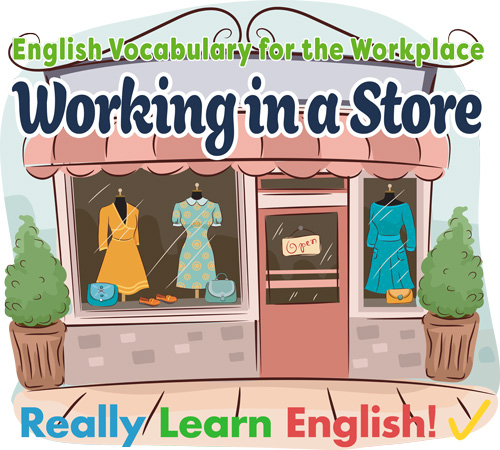
This lesson is part of the English Vocabulary Illustrated Word Lists section. Let's get started!
Click Here for Step-by-Step Rules, Stories and Exercises to Practice All English Tenses
In this lesson, we will cover these topics:
- People in a Store
- Types of Stores
- Things in a Store
- Payment Related
- Stock
- After the Sale
- Working Hours
- Promotion
People in a Store
Customer
A customer is someone who is buying something in a store. A "regular customer" is a customer who shops often at the same store.
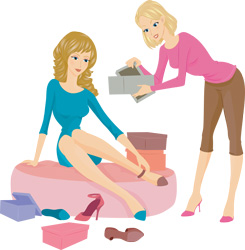
Cashier
A cashier is the person whose job it is to take the customer's money when the customer buys something.
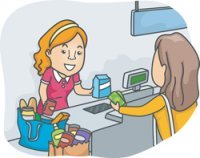
Employee
The word "employee" describes anyone who is working in a job.
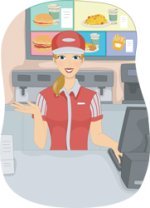
Salesman, Saleswoman, or Salesperson
A salesman, saleswoman, or salesperson is the person who helps a customer select which items to buy.
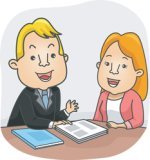
Associate (or: Team Member)
The words "associate" or "team member" describe the employees of a store.
Stocker
The job of a stocker is to put things on the shelves of the store.
Supervisor (or manager or boss)
There are several different words to describe someone who is in charge of other employees: they can be called a supervisor, a manager, or a boss.
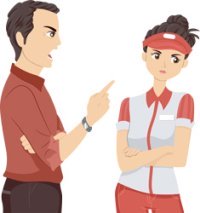
Shoplifter
A shoplifter is someone who steals something from a store.
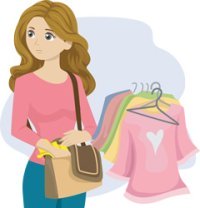
Owner
An owner is someone who owns something; in this case, the person who owns the store is called the "owner."
Types of Stores
Grocery store (or: Supermarket)
A grocery store (or supermarket) sells food. The sections of a grocery store usually include:
- Produce: fresh fruits and vegetables.
- Dairy: milk, yogurt, eggs, and cheese.
- Meats: fresh meat.
- Deli: lunch meats, sliced cheese, and prepared foods that are ready to eat.
- Bakery: bread, rolls, cookies, cakes, and pies.
- Frozen: all foods that are kept frozen.
- Household: cleaning supplies, pet foods, and paper goods.

Convenience store
A convenience store is a small store, located close to homes, that sells a small number of things, usually including snack foods and drinks.
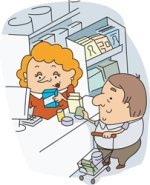
Pharmacy
A pharmacy sells medicine.
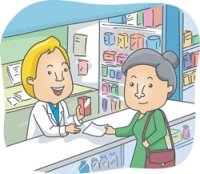
Department store
A department store has several different departments. It usually sells clothing for men, women, and children, along with jewelry, shoes, make-up, and household items such as blankets and towels.
Jeweler
A jeweler sells jewelry.
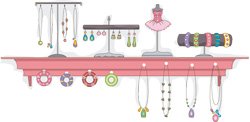
Thrift store
A thrift store sells used items, such as clothing and furniture.
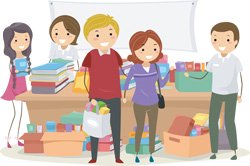
Shopping mall (or: Mall)
A shopping mall is a large indoor building with many smaller shops in it and a few large shops. It also usually has several places to eat.
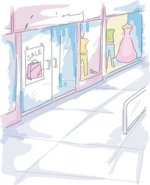
Strip center
A strip center is an outdoor shopping area where the shops are arranged in a row. There is usually a parking area in the front.
Discount store
A discount store sells items for less money than other stores.
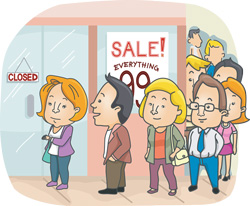
Big Box Store
A "big box" store is a very large store. It is usually part of a chain of stores.
Hardware store
A hardware store sells tools and other materials for building, fixing, and changing a building or a home.
Online Store
An online store is one where the customer places their order on a computer and the items are delivered to the customer's home.
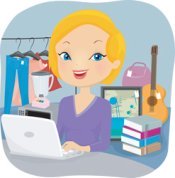
Brick-and-Mortar
A brick-and-mortar store is a physical store, not an online store.
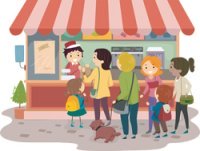
Chain Store
A chain store is a store that has more than one location.
Mom and Pop Store
A "mom and pop" store is a small store that is not part of chain and is usually owned by one family.
Specialty Store
A specialty store is a store that sells one kind of item, and it is usually an unusual item.
Warehouse Store
A warehouse store is a very large store where the customer normally has to buy more than one of an item at a time but pays less for the items.
Dollar Store
A "dollar store" is a store where every item in the store is sold for one dollar.
Outlet Mall
An outlet mall is a mall where the stores sell their products for less than they sell them for at other locations of the same chain. Sometimes, these are items with defects or that did not sell elsewhere.
Things in a Store
Cash Register
A cash register is a machine that calculates how much a customer owes for the products that he or she is purchasing, tells how much change the customer should get, and has a place to store the money that is paid to the store. It can usually also print a receipt.
Receipt
A receipt is a piece of paper that shows what a customer bought and how much it cost.
Gift receipt
A gift receipt is a receipt that does not show the prices of the items. A customer can request a gift receipt if they are going to give the item that they have purchased as a gift and they would like the person who gets the gift to have a receipt in case they want to exchange the item, but they do not want the person to know how much the gift cost.
Shelves
A shelf is a flat surface, usually made of wood or metal, and attached to a wall or another structure. In a store, products are placed on shelves so that customers can see them and reach them.
Barcode
A barcode is a special pattern of lines that are thick and thin. It is found on most products and, when it is scanned by a computer, it gives the computer information about the product, such as how much the product cost.
Aisle
An aisle is a gap between rows of shelves where customers can walk.
Shopping cart
A shopping cart is a large basket on wheels that a customer can put the things that they are buying into while they shop.
Shopping basket
A shopping basket is a special basket provided by a store that the customer can carry around the store and place items in as they shop.
Escalator
An escalator is a moving staircase found in some large stores. It allows customers and employees to move quickly from one floor of the store to another. An "up escalator" goes up and a "down escalator" goes down.
Scale
A scale is a machine that measures how much something weighs.
Fitting room (or: changing room)
A fitting room (or a changing room) is a small room that a customer can go into to try on clothes in a store. It has mirrors so the customer can see how the clothes look.
Payment
When a customer pays for their goods, this is called the "payment." There are several ways to make a payment:
- Cash and coins: paper bills and metal pieces that are recognized as money.
- Check: a form that the customer writes on and signs. The customer's bank then gives the store the money that is owed.
- Credit card: a plastic card used for payment; the customer pays the bill at the end of the month.
- Debit card: a plastic card used for payment; the customer has to place money on the account in advance.
Loyalty card
Some stores have loyalty cards. If the customer shows the cashier this card when they make a purchase, the store's computer will keep track of what the customer has purchased and the customer may get a discount or free item.
PIN
A PIN is a number, usually with four digits, that a customer enters when they are paying so that their bank knows that the correct person is using a credit card or debit card.
Checkout
The checkout is the area of the store where the customer goes to pay for their items.
Coupon
A coupon is a piece of paper that a customer shows to a cashier in order to get a discount. Usually, a coupon will have been mailed or given to the customer in advance.
Expiration Date
An expiration date is the date when a product is no longer good or safe.
Merchandise (or: Goods)
"Merchandise" refers to the things that are for sale in a store. These are also called "goods."
Security Device
A security device in a store is a special tag that is attached to an item that is expensive. When a customer pays for the item, the tag is removed. If a customer tries to leave the store without paying for the item, an alarm will sound.
Gift certificate (or: Gift Card)
A gift certificate (or a gift card) is a piece of paper or a plastic card that someone buys at a store. They give it to someone else as a gift. Then, that person can use the gift card like money in that store.
Rain check
If a store has an item on sale but runs out of it, they might issue a "rain check," which is a piece of paper that says that the customer can come to the store another time—even after the sale ends—and purchase the item for the sale price.
Register tape
Register tape refers to a long, thin roll of paper that is placed into the cash register. The receipt is printed on the register tape and then the cashier rips the tape and gives the receipt to the customer.
Safe
A safe is a heavy metal box with a strong lock. Many stores have one in a back room and it is used to store money.
Price Tag
A price tag is a small piece of paper or a sticker that tells how much something costs. It is attached to an item that is for sale.
Payment Related
Order
An order is a request to buy items.
Price
The price refers to the amount of money that a customer has to pay for an item.
Discount
A discount occurs when a store sells something for less than they usually sell it.
Buy One, Get One Free
A "buy one, get one free" sale means that if a customer pays for one item, they will get a second (identical) item without paying for it.
Cash Discount
Some stores offer a cash discount, which means that a customer pays less if they pay with cash (instead of a credit card.)
Bulk Order
A bulk order means that a customer is placing a large order of one item, usually at a discount.
Quantity Discount
A quantity discount is given by some stores if a customer buys a lot of items or spends a lot of money.
Invoice
An invoice is a piece of paper that lists the items purchased and shows how much the customer should pay.
Sale
A sale occurs any time a store sells an item for less than the usual price.
Retail
The "retail" price of the item is the price that a customer normally pays for the item.
Wholesale
The "wholesale" price of an item is how much the store paid to buy the item.
Profit
The profit is how much money the store makes from selling an item. To figure out the profit, take the price that the customer paid and subtract the wholesale price of the item and the expenses of running the store.
Bill
The bill is a piece of paper that lists what items were purchased and how much the customer owes.
Change
In a store, "change" refers to the coins that a cashier gives to a customer if a customer has paid in cash and has paid more than the exact amount of the bill.
Charge
In a store, to "charge" means to pay for something with a credit card.
Price override
Some computerized cash registers automatically charge a certain price for an item. If the cashier wants to charge the customer a different price for the item, this is called a "price override."
Swipe
In a store, to "swipe" means to quickly move a credit card or debit card through the slot in the payment machine so that the machine can read the data on the card.
Tax (or: Sales tax)
Many cities and states charge a tax (or sales tax) when certain items are purchased. This is an amount of money that the customer has to pay in addition to the cost of the item. This money is given to the government.
Tax Exempt
"Tax exempt" means that no tax is owed. Certain items may be tax exempt. Also, purchases for certain groups (such as churches or charities) may be tax exempt.
Transaction
In a store, the word "transaction" refers to the payment made by a customer in exchange for an item.
Void
To "void" something means to get rid of it. In a store, it is used when a cashier removes a charge for an item from the customer's bill.
Scan
In a store, "to scan" an item means to move it across a special sensor so that the computer can read the price of the item from the bar code.
Commission
In some stores, the employees work "on commission," which means that they get a small portion of the price of every item that they sell. This amount of money is called their "commission."
Check out
"Check out" is both a noun and a verb phrase. As a noun, it refers to the place in a store where the customer pays for their items. As a verb phrase, it refers to the process of paying for items at a store.
Layaway
Some stores have a layaway policy. This means that a customer selects an item that they want to purchase and the store sets it aside so that no one else can purchase it. The customer returns several times to the store to make small payments on the item. Once the customer has paid for the entire cost of the item, they can take the item home.
Stock
Size
The size refers to how big or small something is. Common sizes are, in order from smallest to greatest:
- Extra-small
- Small
- Medium
- Large
- Extra-large
Quantity
"Quantity" refers to the number of things.
In Stock
Items are "in stock" if they are currently available in the store to buy.
Out of Stock
An item is "out of stock" if it is not currently available in the store to buy.
Discontinued
An item is "discontinued" if the manufacturer of the item is no longer making it.
Manufacturer
The manufacturer is the company that makes an item, usually in a factory.
Backorder
An item is "on backorder" if the store does not have any in stock and the manufacturer can not send new items right away.
Age restricted
Some stores sell items that are age restricted. This means that people who are under a certain age are not allowed to buy the item by law.
Second-Hand
"Second hand" refers to items that have been owned and used by someone else but are for sale again.
Reconditioned
Some electronics and other items are sold as "reconditioned," which means that a previous customer purchased them, found a problem with them, returned them, and the manufacturer fixed the item and is now selling it again to another customer.
Brand
A brand refers to a product made by a certain company.
Generic
A generic product is one that does not have the name of the company that made it on the product.
Try on
In a clothing store, customers will "try on" clothing, meaning that they will put the clothing on and look in a mirror to see if they like the clothing and if it fits before they buy it.
After the Sale
Shipping
Some stores offer shipping, which means that a postal service or delivery service will take the item to the customer's home or business instead of the customer needing to transport the item themselves.
Delivery
Some stores offer a delivery service, which means that they will move a large item that a customer has purchased (such as furniture) from the store to the customer's home or office.
Shipping is the term used for small items while delivery is the term used for larger items.
Sell out
A store will "sell out" of an item if they have sold all of the items that they have in stock.
Return
To return an item means that a customer brings an item that they have already purchased and taken home back to the store.
Exchange
To exchange an item means that a customer has already purchased an item and taken it home, but takes it back to the store and trades it for another item.
Refund
A refund occurs when a customer brings an item back to the store after purchasing it and taking it home and gets back the money that they have paid for the item.
Return policy
Most stores have a return policy. This refers to the rules that are in place when a customer wants to return an item. The policy might state, for example, that the customer has to have a receipt to return the item or that items can only be returned within thirty days of the time that they were purchased.
Price adjustment
Some stores offer a price adjustment. This means that if a customer buys an item and the item later goes on sale, the store will refund the difference between the regular price and the sale price to the customer.
Damaged (or: Defective)
In a store, damaged or defective items are those items that have something wrong with them.
Deactivate
If an item has a security tag, the item has to be "deactivated" before the customer leaves the store or the item will set off the security alarm.
Working Hours
Shift
A "shift" refers to the time that an employee is supposed to be at work.
Schedule
A schedule lists all of the times that all of the employees are supposed to be at work.
Hours
"Hours" refers to the times that a store is open.
Opening time
The opening time is the time that a store opens.
Closing time
The closing time is the time that a store closes.
Break
Most store employees are given a break, which is a short period of time to rest in the middle of their shift.
Promotion
Promotion
Promotion is activities done to increase the sales. A promotion is also a sale or any other event designed to increase a store's sales.
Flyer (or: Circular)
A flyer or circular is a piece of paper (or a few pieces of paper) that arrives at a customer's home either in the mail or in the newspaper and that has advertisements for a store's sales.
Sample
Some stores give small amounts of their products to the customers for free so the customer can learn about the product. This small amount of a free product is called a "sample."
Free Trial
Some stores allow customers to use their products for a short amount of time without paying for them. This is called a "free trial."
Catalogue
A catalogue is a short, printed book that a company mails to a customer's home in order to advertise their products.
Black Friday
In the United States, "Black Friday" is the day after Thanksgiving. This is a time when stores offer sales and many people shop, particularly early in the morning.
Get Updates, Special Offers, and English Resources
Download your FREE GIFT (the first two chapters of
English Short Stories Book and Workbook)
as soon as you join!

By submitting your email, you consent to receiving updates and newsletters from us and to the sharing of your personal data with third parties for the purposes of sending you communications. We will not spam you. You can unsubscribe at any time. For more information, please see our privacy policy.





